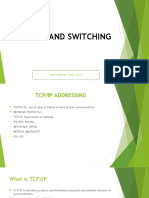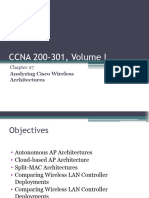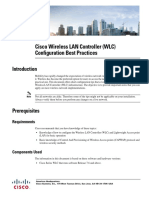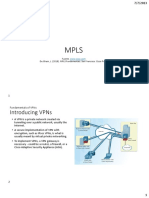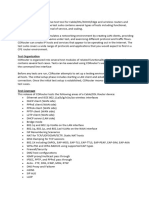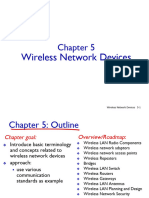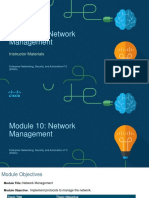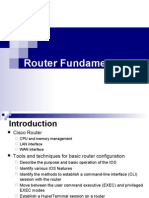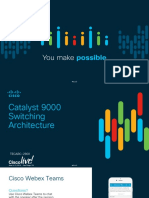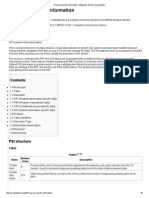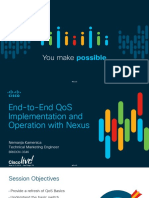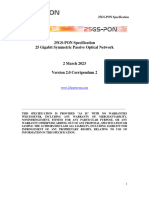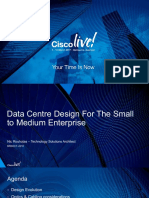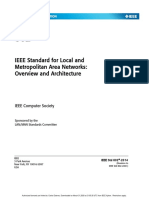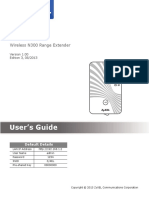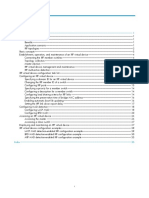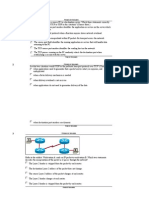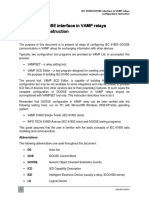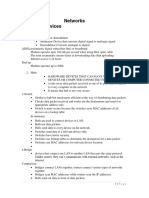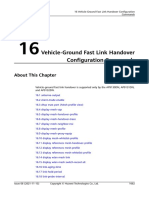Chapter 1: Introduction
to Switched Networks
Routing and Switching
Presentation_ID
2008 Cisco Systems, Inc. All rights reserved.
Cisco Confidential
�Chapter 1
1.0 Introduction
1.1 LAN Design
1.2 Switched Environment
1.3 Summary
Presentation_ID
2008 Cisco Systems, Inc. All rights reserved.
Cisco Confidential
�Chapter 1: Objectives
Upon completion of this chapter, you will be able to:
Describe convergence of data, voice, and video in the context of
switched networks.
Describe a switched network in a small-to-medium-sized business.
Explain the process of frame forwarding in a switched network.
Compare a collision domain to a broadcast domain.
Presentation_ID
2008 Cisco Systems, Inc. All rights reserved.
Cisco Confidential
�Converged Networks
Growing Complexity of Networks
Our digital world is
changing.
Information must
be accessed from
anywhere in the
world.
Networks must be
secure, reliable,
and highly
available.
Presentation_ID
2008 Cisco Systems, Inc. All rights reserved.
Cisco Confidential
�Converged Networks
Elements of a Converged Network
Collaboration is a
requirement.
To support collaboration,
networks employ
converged solutions.
Data services include
voice systems, IP phones,
voice gateways, video
support, and video
conferencing.
Call control, voice
messaging, mobility, and
automated attendant are
also common features.
Presentation_ID
2008 Cisco Systems, Inc. All rights reserved.
Cisco Confidential
�Converged Networks
Benefits of a Converged Network
Multiple types of traffic;
only one network to
manage.
Substantial savings over
installation and
management of
separate voice, video,
and data networks.
Integrates IT
management.
Presentation_ID
2008 Cisco Systems, Inc. All rights reserved.
Cisco Confidential
�Converged Networks
Borderless Switched Networks
The Cisco Borderless Network is a network architecture that
allows organizations to connect anyone, anywhere, anytime,
and on any device securely, reliably, and seamlessly.
Cisco Borderless Network is designed to address IT and
business challenges, such as supporting the converged
network and changing work patterns.
Presentation_ID
2008 Cisco Systems, Inc. All rights reserved.
Cisco Confidential
�Converged Networks
Hierarchy in the Borderless Switched
Network
Borderless
switched network
design guidelines
are built upon the
following principles:
Hierarchical
Modularity
Resiliency
Flexibility
Presentation_ID
2008 Cisco Systems, Inc. All rights reserved.
Cisco Confidential
�Presentation_ID
2008 Cisco Systems, Inc. All rights reserved.
Cisco Confidential
�Presentation_ID
2008 Cisco Systems, Inc. All rights reserved.
Cisco Confidential
10
�Converged Networks
Core, Distribution, Access
Presentation_ID
2008 Cisco Systems, Inc. All rights reserved.
Cisco Confidential
11
�Switched Network Layer
Presentation_ID
2008 Cisco Systems, Inc. All rights reserved.
Cisco Confidential
12
�Switched Networks
Role of Switched Networks
Switching technologies are crucial to network design.
Switching allow traffic to be sent only where it is needed in most
cases, using fast methods.
A switched LAN:
Allows more flexibility
Allows more traffic management
Supports quality of service, additional security, wireless, IP
telephony, and mobility services
Presentation_ID
2008 Cisco Systems, Inc. All rights reserved.
Cisco Confidential
13
�Switched Networks
Form Factor
Fixed
Platform
Presentation_ID
2008 Cisco Systems, Inc. All rights reserved.
Cisco Confidential
14
�Switched Networks
Form Factor (cont.)
Modular
Platform
Presentation_ID
2008 Cisco Systems, Inc. All rights reserved.
Cisco Confidential
15
�Switched Networks
Form Factor (cont.)
Stackable
Platform
Presentation_ID
2008 Cisco Systems, Inc. All rights reserved.
Cisco Confidential
16
�Frame Forwarding
Switching as a General Concept
A switch makes a decision based on ingress and a destination
port.
A LAN switch keeps a table that it uses to determine how to
forward traffic through the switch.
Cisco LAN switches forward Ethernet frames based on the
destination MAC address of the frames.
Presentation_ID
2008 Cisco Systems, Inc. All rights reserved.
Cisco Confidential
17
�Presentation_ID
2008 Cisco Systems, Inc. All rights reserved.
Cisco Confidential
18
�Frame Forwarding
Dynamically Populating a Switch MAC
Address Table
A switch must first learn which devices exist on each port before it
can transmit a frame.
It builds a table called a MAC address or content addressable
memory (CAM) table.
The mapping device <-> port is stored in the CAM table.
CAM is a special type of memory used in high-speed searching
applications.
The information in the MAC address table used to send frames.
When a switch receives an incoming frame with a MAC address that
is not found in the CAM table, it floods it to all ports, but the one that
received the frame.
Presentation_ID
2008 Cisco Systems, Inc. All rights reserved.
Cisco Confidential
19
�Process of building the MAC addresses
Switch
examine
the
source
MAC address
After
record,
examine
dest.
MAC
address
Switch
receive
a
frame
from
PC1
on
Port
1
Dest.
Device
reply
with
unicast
frame
towithout
PC1
Switch
forward
frame
betw.
source
dan
dest.
switch
enter
the
info.
To
MAC
addr.
table
- -The
If
x
:
associates
the
source
MAC
address
PC1
with
Port
1
If x : flood to all portflooding
except ingress port
- If yes : reset aging timer
Presentation_ID
2008 Cisco Systems, Inc. All rights reserved.
Cisco Confidential
20
�Frame Forwarding
Switch Forwarding Methods
Add a header
Presentation_ID
2008 Cisco Systems, Inc. All rights reserved.
Cisco Confidential
21
�Video : Store-and-Forward Switching
Presentation_ID
2008 Cisco Systems, Inc. All rights reserved.
Cisco Confidential
22
�Cut Through Switching
Presentation_ID
2008 Cisco Systems, Inc. All rights reserved.
Cisco Confidential
23
�Frame Forwarding
Store-and-Forward Switching
Allows the switch to:
Check for errors (via FCS
check)
Perform automatic
buffering
Slower forwarding process
Presentation_ID
2008 Cisco Systems, Inc. All rights reserved.
Cisco Confidential
24
�Frame Forwarding
Store-and-Forward Switching (cont.)
Presentation_ID
2008 Cisco Systems, Inc. All rights reserved.
Cisco Confidential
25
�Frame Forwarding
Cut-Through Switching
Allows the switch to start forwarding in about 10 microseconds
No FCS check
No automatic buffering
Presentation_ID
2008 Cisco Systems, Inc. All rights reserved.
Cisco Confidential
26
�Frame Forwarding
Cut-Through Switching (cont.)
Presentation_ID
2008 Cisco Systems, Inc. All rights reserved.
Cisco Confidential
27
�Switched Environment
Filter frames
DO NOT filter broadcast frames
Flood broadcast frames all ports
Router can segment collision & broadcast domain
MAC address all binary one
Broadcast reduce net. Efficiency congestion
LAN switch unicast can be sent to and/or received by hosts
LAN switch multicast can be sent to and/or received by hosts
LAN broadcast can be sent to and/or received by hosts
Presentation_ID
2008 Cisco Systems, Inc. All rights reserved.
Cisco Confidential
28
�Activity
Presentation_ID
2008 Cisco Systems, Inc. All rights reserved.
Cisco Confidential
29
�Switching Domains
Collision Domains
A collision domain is the segment where devices must compete to
communicate.
All ports of a hub belong to the same collision domain.
Every port of a switch is a collision domain on its own.
A switch break the segment into smaller collision domains, easing
device competition.
Presentation_ID
2008 Cisco Systems, Inc. All rights reserved.
Cisco Confidential
30
�Switching Domains
Broadcast Domains
A broadcast domain is the extend of the network where a broadcast
frame can be heard.
Switches forward broadcast frames to all ports; therefore, switches
do not break broadcast domains.
All ports of a switch, with its default configuration, belong to the
same broadcast domain.
If two or more switches are connected, broadcasts are forwarded to
all ports of all switches, except for the port that originally received
the broadcast.
Presentation_ID
2008 Cisco Systems, Inc. All rights reserved.
Cisco Confidential
31
�Broadcast Domain
Presentation_ID
2008 Cisco Systems, Inc. All rights reserved.
Cisco Confidential
32
�Switching Domains
Alleviating Network Congestion
Switches help alleviating network congestion by:
Facilitating the segmentation of a LAN into separate collision
domains
Providing full-duplex communication between devices
Taking advantage of their high-port density
Buffering large frames
Employing high-speed ports
Taking advantage of their fast internal switching process
Having a low, per-port cost
Presentation_ID
2008 Cisco Systems, Inc. All rights reserved.
Cisco Confidential
33
�Chapter 1: Summary
In this chapter, you learned:
The trend in networks is towards convergence using a single set of
wires and devices to handle voice, video, and data transmission.
There has been a dramatic shift in the way businesses operate.
There are no physical offices or geographic boundaries constraints.
Resources must now be seamlessly available anytime and
anywhere.
The Cisco Borderless Network architecture enables different
elements, from access switches to wireless access points, to work
together and allow users to access resources from any place at any
time.
Presentation_ID
2008 Cisco Systems, Inc. All rights reserved.
Cisco Confidential
34
�Chapter 1: Summary (cont.)
The traditional, three-layer hierarchical design model divides the
network into core, distribution, and access layers, and allows each
portion of the network to be optimized for specific functionality.
It provides modularity, resiliency, and flexibility, which provides a
foundation that allows network designers to overlay security,
mobility, and unified communication features.
Switches use either store-and-forward or cut-through switching.
Every port on a switch forms a separate collision domain allowing for
extremely high-speed, full-duplex communication.
Switch ports do not block broadcasts and connecting switches can
extend the size of the broadcast domain, often resulting in degraded
network performance.
Presentation_ID
2008 Cisco Systems, Inc. All rights reserved.
Cisco Confidential
35
�Presentation_ID
2008 Cisco Systems, Inc. All rights reserved.
Cisco Confidential
36




